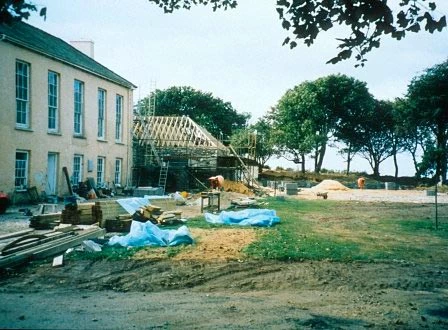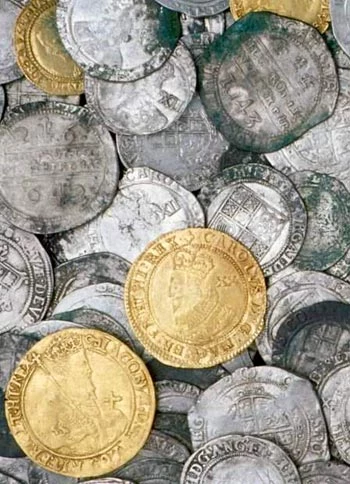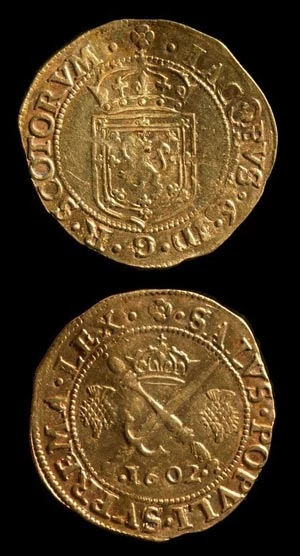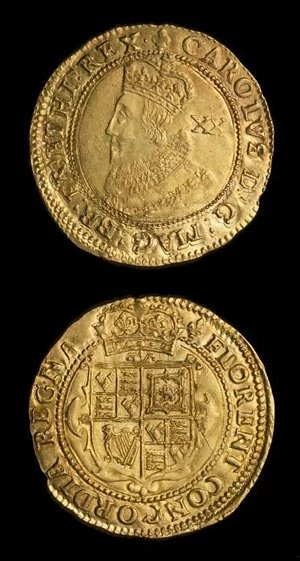The 'legendary' treasure of Tregwynt
Tregwynt Mansion, September 1996: the tennis court under construction.
The Tregwynt hoard: a selection of the coins as found.
A Scottish Sword-and-Sceptre piece of James VI, 1602. The money brought south by James in 1603 when he became King of England was made legal tender in England and Wales.
A gold Pound coin: a twenty-shillings piece of King Charles I (1625-49).
A silver half crown (2s 6d [12½p]) of Charles I, 1642. Struck at an emergency mint at Shrewsbury at the beginning of the Civil War, this was a day's pay for a cavalryman. On the back, the King promises to fight for the Laws of England, the Protestant religion and the Liberty of Parliament. Round the edge: 'Let God arise, let his enemies be scattered!'
Tregwynt Mansion, Fishguard, Pembrokeshire
Each year Amgueddfa Cymru receives a few chance finds of coins and tokens, but occasionally something more spectacular comes to light. On 17th September 1996, one of Wales' finest coin hoards was discovered.
The story begins in 1996 at Tregwynt Mansion, not far from Fishguard, Pembrokeshire, when the owners were building a tennis court. As they levelled the site and removed the topsoil, a few coins were uncovered. As more soil was removed, more coins were found and after a few days 87 silver and gold coins had been uncovered dating from the 16th and 17th centuries.
An initial news blackout on the discovery proved to be a wise precaution, since by mid October, further searching, helped by a hired JCB, brought the total to 33 gold and 467 silver coins, fragments of pottery, a sheet of lead, and a gold ring! At a coroner's inquest at Haverfordwest on 12th June 1997, the coins and ring were declared treasure trove.
The Museum was able to acquire the hoard with the aid of the Heritage Lottery Fund.
Why is the Tregwynt hoard special?
The Tregwynt Hoard is one of the finest coin hoards ever recovered from Wales. At the time of its burial it was worth £51 9s. (in today's terms perhaps around £10,000) - enough to pay fifty soldiers for about a month.
The hoard contains an unusually wide range of mid-17th century currency in gold and silver, including a gold crown (five shillings) dating back to the time of Henry VIII.
The coins cover a range of values and reigns: sixpences and shillings of Edward VI (1547-53), Philip and Mary (1554-8), Elizabeth I (1558-1603), The remaining English gold coins are of James I (1603-25) and Charles I (1625-49), but there is also one Scottish gold coin of James VI dated 1602, just before he became king of England.
Tregwynt is unusual in containing coins from no fewer than seven of the emergency mints operated by the royalists during the Civil War. There are also two very rare Irish coins: a half crown probably issued in 1642 by the rebel Catholic Confederacy, and a crown from an emergency Dublin issue of 1643, probably the first recorded find of this type in a Civil War context in England and Wales.
Dating the Hoard
The latest coin at Tregwynt is a single shilling bearing as its mint-mark a sceptre, in use during 1647 and 1648, so the hoard was buried no earlier than 1647.
Oliver Cromwell and the Battle of St. Fagans
Tregwynt is the first 'Civil War' coin hoard to be recorded from Pembrokeshire, and although the hoard's burial cannot be dated with any precision, it seems likely that the county was a major focus of the so-called 'Second Civil War' - a series of royalist risings during the first half of 1648. In February that year Colonel Poyer, a staunch parliamentarian, refused to hand over Pembroke Castle to Colonel Fleming, and by March was in revolt. The parliamentarians were driven out of Pembrokeshire and the royalists were only finally halted at the battle of St Fagans, near Cardiff on the 8th May 1648. The revolt brought Oliver Cromwell to west Wales in person to attack Pembroke Castle, which did not surrender until 11th July.
When, By Who and Why?
It is highly likely, therefore, that burial of the Tregwynt hoard relates to the events of 1648. Who owned it? This we shall never know for certain, but whoever it was never came back to collect it.
The occupier of Tregwynt at the time was Llewellin Harries, an important farmer who died in 1663 and had at least twelve children. As the hoard was buried in a pot covered by a lead sheet, in an outbuilding it suggests that one of the family was probably involved in its burial: but was it the owner?
In the confused times of civil war, almost anything is possible. There is some slight evidence that the Harries were royalist, but if so, they seem to have kept out of the way when it came to the post-war fines imposed on the King's supporters.
Three men named Harries fought for the king at St Fagans but none were definitely connected with Tregwynt. The gold ring, which is presumed to have belonged to the hoard, is a 'posy' (motto) ring inscribed 'Rather death then [than] falce of fayth' - but the meaning cannot be assumed, nor its owner identified.
The Tregwynt Legend
There has long been a legend of treasure at Tregwynt, of valuables supposedly hidden in a hurry when the 1797 French invasion at Fishguard interrupted a ball at the mansion. Reality has proved somewhat different. We shall never know the full story of the Tregwynt treasure, but it stands out as a fine example of the currency of Wales in the early modern period and a spectacular reminder of the disruption visited upon every community during the English Civil War.
Background Reading
'A Civil War hoard from Tregwynt, Pembrokeshire' by E. Besly. In British Numismatic Journal, vol. 68, p119-36 (1998).
'Welsh treasure from the English Civil War' by E. Besly. In Minerva, vol. 9(4), p49-51 (July/August 1998).




![A silver half crown (2s 6d [12½p]) of Charles I, 1642](/media/2931/version-full/emergancy-coinage.webp)
Comments - (2)
Hi there Meryl
Thanks for your enquiry. I will follow up by email so that you can speak to one of our curators directly about viewing the hoard.
Best wishes,
Sara
Digital Team